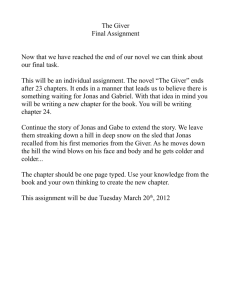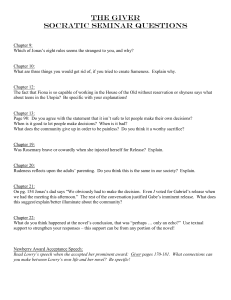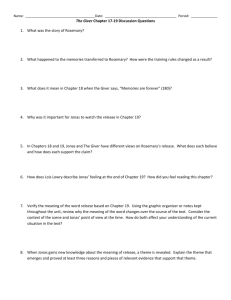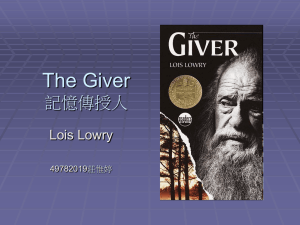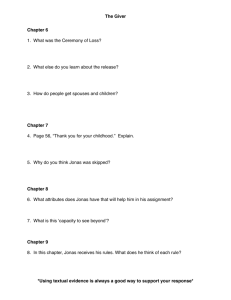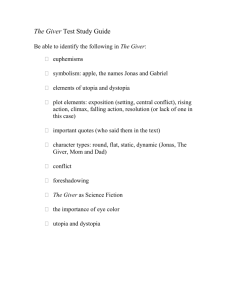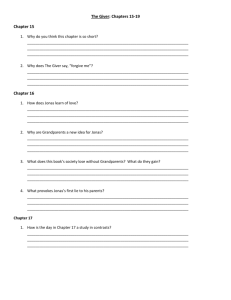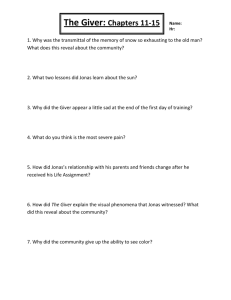The Giver - Oregon Children's Theatre
advertisement
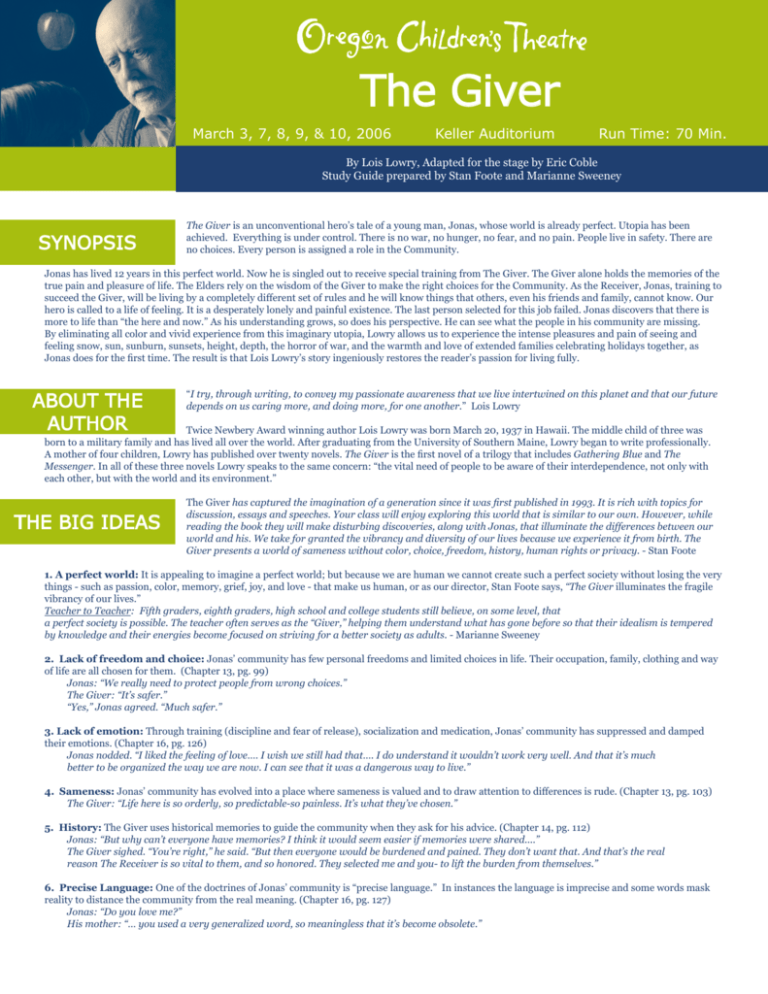
The Giver March 3, 7, 8, 9, & 10, 2006 Keller Auditorium Run Time: 70 Min. By Lois Lowry, Adapted for the stage by Eric Coble Study Guide prepared by Stan Foote and Marianne Sweeney SYNOPSIS The Giver is an unconventional hero’s tale of a young man, Jonas, whose world is already perfect. Utopia has been achieved. Everything is under control. There is no war, no hunger, no fear, and no pain. People live in safety. There are no choices. Every person is assigned a role in the Community. Jonas has lived 12 years in this perfect world. Now he is singled out to receive special training from The Giver. The Giver alone holds the memories of the true pain and pleasure of life. The Elders rely on the wisdom of the Giver to make the right choices for the Community. As the Receiver, Jonas, training to succeed the Giver, will be living by a completely different set of rules and he will know things that others, even his friends and family, cannot know. Our hero is called to a life of feeling. It is a desperately lonely and painful existence. The last person selected for this job failed. Jonas discovers that there is more to life than “the here and now.” As his understanding grows, so does his perspective. He can see what the people in his community are missing. By eliminating all color and vivid experience from this imaginary utopia, Lowry allows us to experience the intense pleasures and pain of seeing and feeling snow, sun, sunburn, sunsets, height, depth, the horror of war, and the warmth and love of extended families celebrating holidays together, as Jonas does for the first time. The result is that Lois Lowry’s story ingeniously restores the reader’s passion for living fully. ABOUT THE AUTHOR “I try, through writing, to convey my passionate awareness that we live intertwined on this planet and that our future depends on us caring more, and doing more, for one another.” Lois Lowry Twice Newbery Award winning author Lois Lowry was born March 20, 1937 in Hawaii. The middle child of three was born to a military family and has lived all over the world. After graduating from the University of Southern Maine, Lowry began to write professionally. A mother of four children, Lowry has published over twenty novels. The Giver is the first novel of a trilogy that includes Gathering Blue and The Messenger. In all of these three novels Lowry speaks to the same concern: “the vital need of people to be aware of their interdependence, not only with each other, but with the world and its environment.” THE BIG IDEAS The Giver has captured the imagination of a generation since it was first published in 1993. It is rich with topics for discussion, essays and speeches. Your class will enjoy exploring this world that is similar to our own. However, while reading the book they will make disturbing discoveries, along with Jonas, that illuminate the differences between our world and his. We take for granted the vibrancy and diversity of our lives because we experience it from birth. The Giver presents a world of sameness without color, choice, freedom, history, human rights or privacy. - Stan Foote 1. A perfect world: It is appealing to imagine a perfect world; but because we are human we cannot create such a perfect society without losing the very things - such as passion, color, memory, grief, joy, and love - that make us human, or as our director, Stan Foote says, “The Giver illuminates the fragile vibrancy of our lives.” Teacher to Teacher: Fifth graders, eighth graders, high school and college students still believe, on some level, that a perfect society is possible. The teacher often serves as the “Giver,” helping them understand what has gone before so that their idealism is tempered by knowledge and their energies become focused on striving for a better society as adults. - Marianne Sweeney 2. Lack of freedom and choice: Jonas’ community has few personal freedoms and limited choices in life. Their occupation, family, clothing and way of life are all chosen for them. (Chapter 13, pg. 99) Jonas: “We really need to protect people from wrong choices.” The Giver: “It’s safer.” “Yes,” Jonas agreed. “Much safer.” 3. Lack of emotion: Through training (discipline and fear of release), socialization and medication, Jonas’ community has suppressed and damped their emotions. (Chapter 16, pg. 126) Jonas nodded. “I liked the feeling of love…. I wish we still had that…. I do understand it wouldn’t work very well. And that it’s much better to be organized the way we are now. I can see that it was a dangerous way to live.” 4. Sameness: Jonas’ community has evolved into a place where sameness is valued and to draw attention to differences is rude. (Chapter 13, pg. 103) The Giver: “Life here is so orderly, so predictable-so painless. It’s what they’ve chosen.” 5. History: The Giver uses historical memories to guide the community when they ask for his advice. (Chapter 14, pg. 112) Jonas: “But why can’t everyone have memories? I think it would seem easier if memories were shared....” The Giver sighed. “You’re right,” he said. “But then everyone would be burdened and pained. They don’t want that. And that’s the real reason The Receiver is so vital to them, and so honored. They selected me and you- to lift the burden from themselves.” 6. Precise Language: One of the doctrines of Jonas’ community is “precise language.” In instances the language is imprecise and some words mask reality to distance the community from the real meaning. (Chapter 16, pg. 127) Jonas: “Do you love me?” His mother: “… you used a very generalized word, so meaningless that it’s become obsolete.” NEW FROM OCT! Scene from Eric Coble’s new script for The Giver, is available to teachers online at www.octc.org/ study_guides.htm DOWNLOAD A SCENE FROM THE GIVER FROM OCT’S WEBSITE As you build curriculum and classroom activities for pre and post field trip, OCT is pleased to provide a key scene from our world premiere script. You can access the scene online at www.octc.org/study_guides.htm. Here are ways you might use the scene to promote student learning: • Stage the scene as a classroom activity, either before or after seeing the play. • Discuss Coble’s script and compare and contrast it with the same scene in the novel, asking students to analyze the choices the playwright made. • Employ either or both of these activities prior to students writing their own scene from another section of the novel, illuminating for students how scripts are formatted, and giving them an opportunity to discuss and learn about plot, character voicing and dialogue structure. INTEGRATING THEATRE IN THE CLASSROOM This is a collection of activities, which may be done after the class has read the book, The Giver, and before they see the play. - MS From the Director: The Community Lois Lowry describes in The Giver is very specific in its structure. The very first step in adapting this book for stage is to imagine The Community. The book gives us many clues to what it looks like; how it operates; the make up of the population; its resources; interactions with other communities; technology; infrastructure and lives of the people in The Community. In order to fully understand all of the elements, we need to break it down and compare it to where we live, our community, our country and our world. This will inform us on how to design the set, costumes, special effects and sound. - Stan Foote BEFORE THE PLAY INTEGRATING THEATRE IN THE CLASSROOM DEFINE JONAS’ COMMUNITY: RESEARCH Session 1: 15 min. for instruction and set up Session 2: 40 min. work time for groups Session 3: 30 min. for groups to present findings to the class If you have a limited amount of time Define Jonas’ Community can be a complete pre-performance activity. Benchmarks E:R:WM E:R:LI E:R:IC E:W:SI E:W:WC E:COMM:DAW Ask each student to prioritize the top three or four topics that s/he would find most engaging to research, by numbering them 1-4. Collect the papers and use them to divide students into interest-based work groups for the next session. Materials • a classroom set of the book, The Giver • a list of Topics for each student • butcher paper • felt markers (different color for each group) • tape • post-it notes or flags to mark pages • paper • writing implements Session 1: Set up. Distribute a paper to each student with the list of Topics of Exploration (below) and a place for their name at the top. Explain that the next day students will be going through their copies of the book collecting information on different aspect of this utopian community, exploring the book like a detective searching for concrete evidence and supporting all research with page references. Topics of Exploration (some may be combined): • Apparel, agriculture, food and basic necessities • Buildings or spaces, public and private • Communication: person to person (precise language), government to the individuals • Education system • Government and rules/methods of enforcement • Landscape: list all landmarks, number of dwellings (Don’t forget the areas Jonas travels while escaping The Community.) • Life schedule: the milestones of life from Newborn to Release from the House of the Old • Population numbers, jobs and hierarchy of the jobs • Recreation • Rituals • Science and medicine • Technology and transportation Session 2: Research. Post the groups by topic. Ask: “What does this Community look like? How does it function?” Each group meets together. They spend 20 min. exploring the book like detectives searching for concrete evidence and supporting all research with page references. It is a good idea for each member of the group to take a chapter or two to complete this in the limited time, taking their own notes silently. Groups then spend the second 20 min. discussing what they found and transferring their findings to a piece of butcher paper, which they mount around the room at the end of the session. Session 3: Present research. A speaker from each group the presents its findings as shown on the butcher paper. This is the research for the artistic design teams in the Create Jonas’ Community on Stage activity. BEFORE THE PLAY Prep Time: 30 min. • Session 1: 10 min. • Session 2: 40 min. to 1 hour to create designs, with the option to double it if teams are working well and energy is high • Session 3: 20- 30 min. for Teams to present designs to the class Benchmarks E:R:WM E:R:LI E:R:IC E:L:LF E:W:WC E:COMM:CSI E:COMM:BME E:COMM:DAW E:COMM:ERV E:COMM:AIU M:CAL:EST M:MEAS:UT SS:H:USH Materials • the research on Jonas’ Community (still up on butcher paper around the room) • instructions for each team, as given below, either printed for each student, or posted in different areas of the room • paper • more butcher paper • pens, pencils • rulers • a classroom set of the book, The Giver. INTEGRATING THEATRE IN THE CLASSROOM CREATE JONAS ’ COMMUNITY ON STAGE 23 1 Session 1: Set up 1. Explain the whole project (See Integrating Theater in the Classroom, above) and the plan to submit the work of the Teams to OCT for display. 2. Divide your class into four Artist Teams: (See instructions for forming interest-based work groups in Define Jonas’ Community: Session 1: Set Up, previous page.) • Playwrights • Set designers • Costume designers • Lighting/sound/special effects designers 3. Using the research compiled in Define Jonas’ Community, create a script or a design for the specified sections of chapters 10 and 11 of The Giver. A design can consist of a combination of drawing, description of the materials, and the way in which they function. Session 2: Create Instructions for playwriting team: 1. Decide what scenes are needed to tell the story and list them. Example: Scene 1 - Jonas is playing catch with Asher and the apple turns red. Scene 2 - Jonas and family share dreams. Scene 3 - Jonas escapes. 2. Write a three-minute scene of Jonas entering The Giver’s dwelling. Remember to honor the book by using as much of Lowry’s language as possible. Instructions for costume design team: 1. Double check research for all mentions of apparel in the book. Example on page 45: Jonas watched and cheered as Lily marched proudly to the stage, became an eight and received the identifying jacket that she would wear this year, this one with smaller buttons and, for the first time, pockets, indicating that she was mature enough now to keep track of her own small belongings. 2. Discuss color choices with set design team. Your costumes need to stand out on their set. 3. Sketch three costumes: the Giver, Jonas and the female attendant who sits outside the Giver’s dwelling. Instructions for set design team: 1. Find the physical description of the interior of the Giver’s dwelling. This description will tell you how the room looks and functions. Example on page 74: …this room’s walls were completely covered by bookcases, filled, which reached to the ceilings. 2. Research all the action that takes place in the Giver’s dwelling. Example on page 147: Jonas watched the video screen above the row of switches. Its blank face began to flicker with zigzag lines; then some lines followed by the date and time. 3. Discuss color choices with the costume design team. The costumes should stand out and not disappear on or blend in with your set. 4. Start drawing! Remember this is the space where all the memories are given. How does the bed turn into a sled? Or battle field? Instructions for lighting, sound and special effects team 1. Your design job is to create Jonas’ first memory of sliding downhill on a sled. 2. Consult with the set design team and playwriting team about how they envision that moment. 3. Using the dialogue supplied by the playwriting team, design the sound, lights and special effects for this moment. Remember this is not film. How do we take the audience on Jonas’ journey? Session 3: Present Each team reads their scene or presents their design to class. BIOGRAPHY STUDY GUIDE BY STAN FOOTE & MARIANNE SWEENEY Stan Foote has been Oregon Children’s Theatre’s Artistic Director since 1998. An advocate for theatre education, Mr. Foote works with school districts to help integrate theatre into the classroom. He has taught acting classes locally for 27 years as well as directed shows for many area theatres, including OCT and ART. Marianne Sweeney received her MA in Philosophy and Education from Teachers College, Columbia University in New York City. She taught and worked on curriculum development at Riverdale Grade School, Portland, Oregon for thirty years. Since retirement, Ms. Sweeney has served as a contributing editor for an elementary science lab manual. RESOURCES All quotations from The Giver are referenced using the paperback edition published by Dell Laurel-Leaf in September 2002. RESOURCES FOR OCT’S THE GIVER STUDY GUIDE ARE AVAILABLE AT WWW.OCTC.ORG/STUDY_GUIDES.HTM Thoughts on Freedom • Download this collection of quotes from the OCT website. Also available from The Quotations Page at: http://www.quotationspage.com/subjects/freedom/ BEFORE THE PLAY Class Time: 30 min. Benchmarks E:R:WM E:R:MC E:W:KT SS:CG Materials whiteboard space, overhead projector or chart paper to record random responses and reformulate them into a two column list. DISCUSSION: A PERFECT WORLD - UTOPIA Teacher to teacher: If you should choose not to read the book before coming to the play, have this discussion to prepare your class. This discussion may also be used to introduce the book. Keep all the responses generated in this discussion for possible use later. - MS 1. Ask: “If you had the power to make the world a perfect place, what would it be like?” (Record all responses on whiteboard or overhead. Students will say things such as: People would be nicer. There’s be no crime, There’d be no war, There’d be no illness, People would be happy and safe… etc.) 2. Then focus students a bit more by asking: “I see you’ve mentioned several problems here. Just what problems would you try to eliminate? “Now list the problems they mentioned before in a column and add ones they offer to make the column longer. Your list may look something like the list to the right: Problems Murder Poverty Stealing Illness Hunger Accidents Drug Addiction War Methamphetamine 3. Then say, “If you could start over, on another planet, or in a place far away, how would you organize your new community to prevent or eliminate each of these problems? Let’s start by describing what that perfect place would be like with each of these problems eliminated.” You might wind up with a list similar to the one below. Save this list for after the play. PROBLEM A WORLD IN WHICH… Murder no one is angry enough or crazy enough to kill Stealing everyone has enough so no one wants to steal Hunger everyone has enough food Drought there is enough rain to grow crops all the time Drug addiction drugs are only available through pharmacies Laws are broken people who break the law are changed/reformed or put away so they cannot harm people Illness all people are healthy 4. Then say, “In the play we are going to see, a perfect society has been created and has been in place for at least a century. As you watch the play, think about what is good and what is missing from this perfect world.” AFTER THE PLAY Class time, benchmarks and materials in next column on flip page. DISCUSSION/WRITING/PRESENTATION JIGSAW Use these follow-up questions and the information below to stimulate discussion writing and speaking about the Big Ideas. 1. 20 min. Whole class discussion of Big Idea #1 – A Perfect World. 2. 5 min. Distribute & collect “half-sheets” to assign students to interest-based discussion groups around Big Idea topics 2, 3, 4, 5, and 6. 3. 10 min. Make group lists during teacher prep. 4. 30-40 min. Discussion Groups meet. Each person makes notes for part of a presentation to the class on this topic. 5. 20 min. The five Discussion Groups present their ideas and conclusions to the whole class, in some cases inviting continued discussion. 6. 5 min. Revisit Step 1 and ask, “Is it possible to create a Perfect World?” 1. A Perfect World. Post or distribute the student-generated list you saved from the Before the Play activity entitled: Discussion : A Perfect World – Utopia (Problems/A World in Which….) • Say, “Let’s look at our list from before. Were these problems solved in Jonas’ Community? How?” • Add a third column to the posted list, using chart paper or the whiteboard to list the ways in which Jonas’ community eliminated these problems. • Say, “This ‘perfect society’ turned out to be something less than wonderful. So much so that Jonas risked everything to change it. Each of you will work in a group to consider and discuss one of these disturbing aspects of this ‘perfect community.’ (Distribute the half-sheets.) Please write your name on this half-sheet and indicate your first, second and third choice of topic, so you will be in a discussion group on a topic you are interested in.” 2. Lack of Freedom and Choice. Jonas’ community has few personal freedoms and limited choices in life. Their occupation, family, clothing and way of life are all chosen for them. (Chapter 13, pg. 99) Jonas: “We really have to protect people from wrong choices.” The Giver: “It’s safer.” “Yes,” Jonas agreed. “Much safer.” This is radically different from our American ideal of personal liberty. Benjamin Franklin and others warned the founding fathers: “They that can give up essential liberty to obtain a little temporary safety deserve neither liberty nor safety.” Benjamin Franklin (1706 - 1790), Historical Review of Pennsylvania, 1759 (Continued on flip page...) AFTER THE PLAY Prep 30 min. + 10 to make groups Class Time: 90 – 110 min. Benchmarks E:R:WM E:R:LI E:R:IC E:R:MC E:W:KT E:W:SI E:W:WC E:COMM:CSI E:COMM:BME E:COMM:DAW E:COMM:ERV E:COMM:AIU SS:CG SS:E SS:H:USH Materials • The 2-column list resulting from A Perfect World activity • Half-sheets of paper with Big Ideas 2-6 listed on them (1 for each student) • Discussion Guides for Big Ideas 2-6, 6 copies of each (Made from the materials below) • Copies of the U.S. Constitution available for reference DISCUSSION/WRITING/PRESENTATION JIGSAW ...Continued from flip page. American History – Citizenship Connection: In 1787 the founders of the United States of America were crafting a plan for a new kind of government so that the people of this new country might live in a better more perfect society than any group of people had enjoyed before. The introduction, or Preamble, expresses this desire. “We the People of the United States, in Order to form a more perfect Union, establish Justice, insure domestic Tranquility, provide for the common Defense, promote the general Welfare, and secure the Blessings of Liberty to ourselves and our Posterity do ordain and establish this Constitution for the United States of America.” (NB: In the original, “defense” is spelled “defence”, and is not capitalized. - MS) After they made their plan for government, known as the Constitution, the founders were still concerned enough about personal freedoms that they drafted the first ten amendments, known as The Bill of Rights, and pledged that the new Congress would pass them as soon as they came into session the first time, which they did. The first one reads as follows: The First Amendment Congress shall make no law respecting an establishment of religion, or prohibiting the free exercise thereof; or abridging the freedom of speech, or of the press; or the right of the people peaceably to assemble, and to petition the Government for a redress of grievances. • Why did the people who created Jonas’ community decide that “freedom” and “making choices” were dangerous? • What did the people gain by giving up their freedom? • What personal freedoms are you willing to give up to have a safe and secure life? • How is our community balancing government controls with individual freedoms? • How has this balance changed over time? • Does our community need more or fewer rules? • Do people need to be protected from wrong choices? • When is it right to break the rules? Pocket-sized copies of the U.S. Constitution may be purchased in bulk at a discount from the American Bar Association website: http://www.abanet.org/abastore/index 3. Lack of Emotion. Through training (discipline and fear of release), socialization and medication, Jonas’ community has suppressed and damped their emotions. (Chapter 16, pg. 126) Jonas nodded. “I liked the feeling of love…. I wish we still had that…. I do understand it wouldn’t work very well. And that it’s much better to be organized the way we are now. I can see that it was a dangerous way to live.” • Why did the Elders decide that experiencing emotions would be dangerous? • What was the purpose of sharing dreams at breakfast and the day’s experiences at dinner? • What methods do we use to suppress our emotions? • How are we encouraged to suppress our emotions? • Does it make our lives more comfortable to suppress our emotions? • Does it make our lives better to suppress our emotions? • In what ways do other cultures express their emotions differently than we do? 4. Sameness. Jonas’ community has evolved into a place where sameness is valued and to draw attention to differences is rude. (Chapter 13, pg. 103) The Giver “Life here is so orderly, so predictable-so painless. It’s what they’ve chosen.” • Would knowing that every day will be the same as the next be comforting? • Without pain do we really experience pleasure? Without sadness do we really experience happiness? • Is diversity a liability or an asset to a community? 5. History. The Giver uses historical memories to guide the community when they ask for his advice. (Chapter 14, pg. 112) Jonas: “But why can’t everyone have memories? I think it would seem easier if memories were shared....” The Giver sighed. “You’re right,” he said. “But then everyone would be burdened and pained. They don’t want that. And that’s the real reason The Receiver is so vital to them, and so honored. They selected me and you- to lift the burden from themselves.” • What importance does memory serve to guide individuals? Communities? Nations? • How does our society employ memory or history to guide decisions? • Should we use memory or history more or less? • How are memories exploited? 6. Precise Language. One of the doctrines of Jonas’ community is “precise language.” In instances the language is imprecise and some words mask reality to distance the community from the real meaning. (Chapter 16, pg. 127) Jonas: “Do you love me?” His mother: “… you used a very generalized word, so meaningless that it’s become obsolete.” • How and why does Jonas’ society misuse some words to distance itself from the realities of their world? • How and why does our society misuse some words to distance the realities of death, bodily functions, aging, politics, war, etc.? LOIS LOWRY IN PERSON! CONTACT US This study guide, resources and additional materials are available online at www.octc.org/study_guides.htm. Additional study guides may be mailed to you upon request. Thursday, January 26, 2006 at 7:00 P.M. First Unitarian Church 1011 SW 12th Ave., Portland Tickets: $10 adults, $5 students 503.228.9571 600 SW 10th Avenue / Suite 313 Portland, OR 97205-2724 503-228-9571 www.octc.org BENCHMARK CONNECTIONS E:R:WM English: Reading: Word meaning E:R:LI English: Reading: Locating Information E:R:IC English: Reading: Interential Comprehension E:R:MC English: Reading: Making Connections E:L:LF English: Literature: Literary Forms E:W:KT English: Writing: Knowledge of Topic E:W:SI English: Writing: Structure Information E:W:WC English: Writing: Word Choice E:COMM:CSI English: Communitcation: Convey Supported Ideas E:COMM:BME English: Communitcation: Beginning, Middle and End E:COMM:DAW English: Communitcation: Descriptive Accurate Words E:COMM:ERV English: Communitcation: Eye Contact, Rate, Volume E:COMM:AIU English: Communitcation: Acquire, Interpret and Use Information M:CAL:EST Math: Calculation: Estimation M:MEAS:UT Math: Measurement:Units and Tools SS:CG Social Sciences: Civics and Government SS:E Social Science: Economics SS:H:USH Social Science: History: US History Lois Lowry will discuss The Giver and the role that story and the arts play in the development of youth. Selected scenes from OCT’s world premiere will accompany her talk. Define Jonas’ Community: Research Create Jonas’ Community on Stage A Perfect World: Utopia All Activities are coded for Oregon benchmarks from Oregon Department of Education website: www.ode.state.or.us Discussion/Writing/ Presentation Jigsaw
